Title search results
Showing 1488481 - 1488500 of 1502757 items
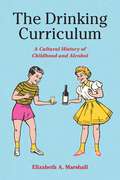
The Drinking Curriculum: A Cultural History of Childhood and Alcohol
By Elizabeth Marshall. 2024
A lively exploration into America’s preoccupation with childhood innocence and its corruptionIn The Drinking Curriculum, Elizabeth Marshall brings the taboo…
topic of alcohol and childhood into the limelight. Marshall coins the term “the drinking curriculum” to describe how a paradoxical set of cultural lessons about childhood are fueled by adult anxieties and preoccupations. By analyzing popular and widely accessible texts in visual culture—temperance tracts, cartoons, film, advertisements, and public-service announcements—Marshall demonstrates how youth are targets of mixed messages about intoxication. Those messages range from the overtly violent to the humorous, the moralistic to the profane. Offering a critical and, at times, irreverent analysis of dominant protectionist paradigms that sanctify childhood as implicitly innocent, The Drinking Curriculum centers the graphic narratives our culture uses to teach about alcohol, the roots of these pictorial tales in the nineteenth century, and the discursive hangover we nurse into the twenty-first.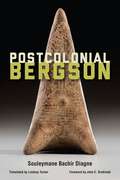
Postcolonial Bergson
By Souleymane Bachir Diagne. 2020
Henri Bergson has been the subject of keen interest within French philosophy ever since being championed by Gilles Deleuze and…
others. Yet his influence extends well beyond European philosophy, especially within Africa and South Asia. Postcolonial Bergson traces the influence of Bergson’s thought through the work of two major figures in the postcolonial struggle, Muhammad Iqbal and Léopold Sédar Senghor. Poets and statesmen as well as philosophers, both of these thinkers—the one Muslim and the other Catholic—played an essential political and intellectual role in the independence of their respective countries. Both found, in Bergson’s work, important support for their philosophical, cultural, and political projects.For Iqbal, a founding father of independent Pakistan, Bergson’s conceptions of time and creative evolution resonated with the need for the “reconstruction of religious thought in Islam,” a religious thought newly able to incorporate innovation and change. For Senghor, Bergsonian ideas of perception, intuition, and élan vital—filtered in part through the work of the French philosopher Pierre Teilhard de Chardin—proved crucial for thinking about African art, as well as foundational for his formulations of African socialism and his visions of an unalienated African future.At a moment of renewed interest in Bergson’s philosophy, this book, by a major figure in both French and African philosophy, gives an expanded idea of the political ramifications of Bergson’s thought in a postcolonial context.
Allergic Intimacies: Food, Disability, Desire, and Risk
By Michael Gill. 2018
The first book to explore food allergies in the United States from the perspective of disability and raceAre food allergies…
disabilities? What structures and systems ensure the survival of some with food allergies and not others? Allergic Intimacies is a groundbreaking critical engagement with food allergies in their cultural representations, advocacy, law, and stories about personal experiences from a disability studies perspective. Author Michael Gill questions the predominantly individualized medical approaches to food allergies, pointing out that these approaches are particularly problematic where allergy testing and treatments are expensive, inconsistent, and inaccessible for many people of color.This thought-provoking book explores the multiple meanings of food allergies and eating in the United States, demonstrating how much more is at stake than we realize, at a critical time when food allergies are on the rise: An estimated 32 million Americans, including one in thirteen children, have food allergies. Diagnoses of food allergies in children have increased by 50 percent since 1997. Yet as the author makes clear, the whiteness of the food allergy community and single-identity disability theory is inherently limiting and insufficient to address the complex choices that those with food allergies make. Gill argues that racism and ableism create unique precarity for disabled people of color that food allergic communities are only beginning to address. There is a huge disparity in access to testing and treatment, with African American and Latinx children having higher risk of adverse outcomes than white children, including more rates of anaphylaxis. Food allergy professionals have a responsibility to move beyond individualized approaches to more robust coalitional efforts grounded in disability and racial justice to undo these patterns of exclusion.Allergic Intimacies celebrates the various creative ways food allergic communities are challenging historical and current practice of exclusion, while identifying the depth of work that still needs to be done to shift focus from a white allergic experience toward a more representative understanding of the racial, ethnic, religious, and economic diversity of those in the United States. Gill’s book is a discerning and vital exploration of the key debates about risks, dangers, safety, representations, and political concerns affecting the lives of individuals with food allergies.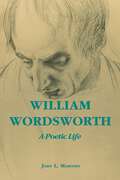
William Wordsworth: A Poetic Life
By John L. Mahoney. 1997
Available in a new digital edition with reflowable text suitable for e-readersWilliam Wordsworth: A Poetic Life is a new biography…
of the great father of British Romanticism. It is new in several ways, most notably in the way it approaches the life of the poet. Paying its proper respect to the classic lives of Wordsworth by Mary Moorman and Stephen Gill, it attempts to tell the story of the life through a more rigorous reading of key and representative works of the poet, through careful blending of life and poetry. Wordsworth offers the story of the literariness of the poet's life - childhood and adolescence in the Lake District, education at Cambridge, love and political radicalism in France, the long period of residence in Grasmere and Rydal, celebrity, and national and international recognition. Its reading of the poems, in tune with current theoretical practice, offers a sense of the continuities in Wordsworth's career as it moves away from familiar theories of a Golden Decade of creativity and a period of long decline. The book also works closely and rigorously with Wordsworth's poetry as a method of dramatizing the essentially poetic character of the poet's life.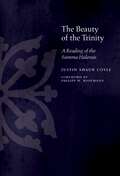
In this book Justin Shaun Coyle remembers the theology of beauty of the forgotten Summa Halensis, an early-thirteenth-century text written…
by Franciscan friars at the University of Paris. Many scholars vaunt the Summa Halensis—conceived but not drafted entirely by Alexander of Hales (d. 1245)—for its teaching on beauty and its influence on giants of the high scholastic idiom. But few read the text’s teaching theologically—as a teaching about God. The Beauty of the Trinity: A Reading of the Summa Halensis proposes an interpretation of the Summa’s beauty—teaching as deeply and inexorably theological, even trinitarian.The book takes as its keystone a passage in which the Summa Halensis identifies beauty with the “sacred order of the divine persons.” If beauty names a trinitarian structure rather than a divine attribute, then the text teaches beauty where it teaches trinity. So The Beauty of the Trinity trawls the massive Summa Halensis for beauty across passages largely ignored by the literature. Taking seriously the Summa’s own definition of beauty rather than imposing onto the text modernity’s narrow aesthetic categories allows Coyle to identity beauty nearly everywhere across the text’s pages: in its teaching on the transcendental determinations of being, on the trinity proper, on creation, on psychology, on grace. A medieval text must teach beauty that appreciates beauty theologically beyond the constricted and anachronistic boundaries that often limit study of medieval aesthetics. Readers of medieval theology and theological aesthetics both will find in The Beauty of the Trinity a depiction of how an early scholastic summa thinks beauty according to the mystery of the trinity.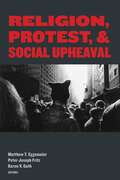
Religion, Protest, and Social Upheaval
By Matthew T. Eggemeier, Peter Joseph Fritz, and Karen V. Guth. 2022
Represents some of the best, cutting-edge thinking available on multiple forms of social upheaval and related grassroots movements.From the January…
2017 Women’s March to the August 2017 events in Charlottesville and the 2020 protests for racial justice in the wake of George Floyd’s murder, social upheaval and protest have loomed large in the United States in recent years. The varied, sometimes conflicting role of religious believers, communities, and institutions in such events and movements calls for scholarly analysis. Arising from a conference held at the College of the Holy Cross in November 2017, Religion, Protest, and Social Upheaval gathers contributions from ten scholars in religious studies, theology and ethics, and gender studies—from seasoned experts to emerging voices—to illuminate this tumultuous era of history and the complex landscape of social action for economic, racial, political, and sexual and gender justice.The contributors consider the history of resistance to racial capitalist imperialism from W. E. B. Du Bois to today; the theological genealogy of the capitalist economic order, and Catholic theology’s growing concern with climate change; affect theory and the rise of white nationalism, theological aesthetics, and solidarity with migrants; differing U.S. Christian churches’ responses to the “revolutionary aesthetics” of the Black Lives Matter movement; Muslim migration and the postsecular character of Muslim labor organizing in the United States; shifts in moral reasoning and religiosity among U.S. women’s movements from the 1960s to today; and the intersection of heresy discourse and struggles for LGBTQ+ equality among Korean and Korean-American Protestants. With this pluralistic approach, Religion, Protest, and Social Upheaval offers a snapshot of scholarly religious responses to the crises and promises of the late 2010s and early 2020s. Representing the diverse coalitions of the religious left, it provides groundbreaking analysis, charts trajectories for further study and action, and offers visions for a more hopeful future.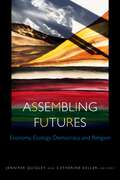
Assembling Futures: Economy, Ecology, Democracy, and Religion (Transdisciplinary Theological Colloquia)
By Jennifer Quigley and Catherine Keller. 2024
Transdisciplinary insights at the intersection of religion, democracy, ecology, and economyWhat is the relationship of religion to economy, ecology, and…
democracy? In our fraught moment, what critical questions of religion may help to assembly democratic processes, ecosystems, and economic structures differently? What possible futures might emerge from transdisciplinary work across these traditionally siloed scholarly areas of interest?The essays in Assembling Futures reflect scholarly conversations among historians, political scientists, theologians, biblical studies scholars, and scholars of religion that transgress disciplinary boundaries to consider urgent matters expressive of the values, practices, and questions that shape human existence. Each essay recognizes urgent imbrications of the global economy, multinational politics, and the materiality of ecological entanglements in assembling still possible futures for the earth. Precisely in their diversity of disciplinary starting points and ethical styles, the essays that follow enact their intersectional forcefield even more vibrantly.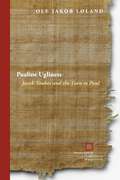
Pauline Ugliness: Jacob Taubes and the Turn to Paul (Perspectives in Continental Philosophy)
By Ole Jakob Løland. 2020
In recent decades Giorgio Agamben, Alain Badiou, and Slavoj Žižek have shown the centrality of Paul to western political and…
philosophical thought and made the Apostle a central figure in left-wing discourses far removed from traditional theological circles. Yet the recovery of Paul beyond Christian theology owes a great deal to the writings of the Jewish rabbi and philosopher Jacob Taubes (1923–1987). Pauline Ugliness shows how Paul became an effective tool for Taubes to position himself within European philosophical debates of the twentieth century. Drawing on Nietzsche’s polemical readings of the ancient apostle as well as Freud’s psychoanalysis, Taubes developed an imaginative and distinct account of political theology in confrontations with Carl Schmitt, Theodor Adorno, Hans Blumenberg, and others. In a powerful reconsideration of the apostle, Taubes contested the conventional understanding of Paul as the first Christian who broke definitively with Judaism and drained Christianity of its political potential. As a Jewish rabbi steeped in a philosophical tradition marked by European Christianity, Taubes was, on the contrary, able to emphasize Paul’s Jewishness as well as the political explosiveness of his revolutionary doctrine of the cross.This book establishes Taubes’s account of Paul as a turning point in the development of political theology. Løland shows how Taubes identified the Pauline movement as the birth of a politics of ugliness, the invention of a revolutionary criticism of the ‘beautiful’ culture of the powerful that sides instead with the oppressed.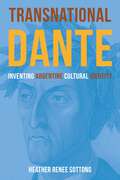
Transnational Dante: Inventing Argentine Cultural Identity (Critical Studies in Italian Migrations)
By Heather Renee Sottong. 2025
Opens the field of Dante Studies to further transnational studies of the Divine Comedy’s circulation, translation, and global influenceThis fascinating…
book examines how Dante was repurposed by Argentine politicians and authors who were concerned with the construction of Argentine national identity in the late nineteenth and early twentieth centuries. Sottong’s work is informed by the theories of Eric Hobsbawm, Benedict Anderson, and Nicolas Shumway, who coined the concepts of “invented traditions,” “imagined communities,” and “guiding fictions,” respectively. Sottong has applied these notions to the case of Argentina, which, after the War of Independence from Spain (1810–1818), had to develop its own national cultural identity.In this volume, she investigates Dante’s transnational influence in Argentina: Why did Argentine authors consistently call upon Dante in their attempts to develop Argentine literature? What are the textual and thematic characteristics of Dante’s Divine Comedy that make it an ideal vehicle for literary appropriation? What are the historical and cultural factors that account for Dante’s enduring popularity in Italy and beyond? How did the strong presence of Italians in Argentina influence cultural production in the developing nation? And how are the re-writings of Dante in the Argentine canon in dialogue with one another?What Sottong found, remarkably, was that rewriting Dante was a way for Argentine authors to voice their views on the direction that should be taken to develop Argentine letters; Dante became something of a literary guide as Argentine intellectuals navigated the complex labyrinth of their national identity. The consistent rewriting of the Divine Comedy in the Argentine context testifies to the fact that great works of literature can be revived during different periods and even reappropriated by various peoples to foster mythologies of inclusion or exclusion related to national identity.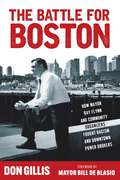
How Mayor Ray Flynn’s leadership and a coalition of activists transformed Boston, challenging established powers and setting new precedents for…
urban governance The Battle for Boston captures the remarkable era under Mayor Ray Flynn, whose election in 1983 marked the beginning of a profound shift in the city’s political and social landscape. Don Gillis, a Flynn senior advisor, chronicles the inspiring journey of a city that dared to challenge the entrenched power brokers—including developers, landlords, and banking industry leaders—through powerful grassroots campaigns.Gillis provides a vivid portrayal of the political dynamics and the coalition of community organizers, neighborhood leaders, and residents that played a pivotal role in rejecting the business-backed growth machine and the city’s historically divisive racial politics. This book charts the strategic battles fought within the corridors of power and on the streets and highlights the substantial impact these movements had on the city’s governance and power dynamics.In a historic turn, in 2021, Michelle Wu became the first woman, person of color, and Asian- American elected Mayor of Boston. Wu’s victory on a similarly progressive platform as Flynn underscores the enduring relevance of his legacy, signaling a hopeful future for more inclusive and effectively governed cities.The Battle for Boston poses a critical inquiry: Can cities truly embrace progressivism and govern effectively in the twenty-first century? This qualitative narrative study is a testament to the possibility of such governance, driven by the indomitable spirit of those who strive for a fair and equitable society.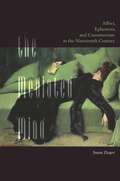
The Mediated Mind: Affect, Ephemera, and Consumerism in the Nineteenth Century
By Susan Zieger. 2018
How did we arrive at our contemporary consumer media economy? Why are we now fixated on screens, imbibing information that…
constantly expires, and longing for more direct or authentic kinds of experience? The Mediated Mind answers these questions by revisiting a previous media revolution, the nineteenth-century explosion of mass print. Like our own smartphone screens, printed paper and imprinted objects touched the most intimate regions of nineteenth-century life. The rise of this printed ephemera, and its new information economy, generated modern consumer experiences such as voracious collecting and curating, fantasies of disembodied mental travel, and information addiction. Susan Zieger demonstrates how the nineteenth century established affective, psychological, social, and cultural habits of media consumption that we still experience, even as pixels supersede paper. Revealing the history of our own moment, The Mediated Mind challenges the commonplace assumption that our own new media lack a past, or that our own experiences are unprecedented.
From a certain perspective, the biggest political story of 2016 was how the candidate who bought three-quarters of the political…
ads lost to the one whose every provocative Tweet set the agenda for the day’s news coverage. With the arrival of bot farms, microtargeted Facebook ads, and Cambridge Analytica, isn’t the age of political ads on local TV coming to a close?You might think. But you’d be wrong to the tune of $4.4 billion just in 2016. In U.S. elections, there’s a lot more at stake than the presidency. TV spending has gone up dramatically since 2006, for both presidential and down-ballot races for congressional seats, governorships, and state legislatures—and the 2020 campaign shows no signs of bucking this trend. When candidates don’t enjoy the name recognition and celebrity of the presidential contenders, it’s very much business as usual. They rely on the local TV newscasts, watched by 30 million people every day—not Tweets—to convey their messages to an audience more fragmented than ever. At the same time, the nationalization of news and consolidation of local stations under juggernauts like Nexstar Media and Sinclair Broadcasting mean a decreasing share of time devoted to down-ballot politics—almost 90 percent of 2016’s local political stories focused on the presidential race. Without coverage of local issues and races, ad buys are the only chance most candidates have to get their messages in front of a broadcast audience. On local TV news, political ads create the reality of local races—a reality that is not meant to inform voters but to persuade them. Voters are left to their own devices to fill in the space between what the ads say—the bought reality—and what political stories used to cover.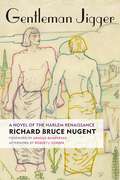
Gentleman Jigger: A Novel of the Harlem Renaissance
By Richard Bruce Nugent. 2025
Gentleman Jigger stands as a landmark novel, celebrated for its candid exploration of Black sexuality set against the dynamic backdrop…
of the Harlem Renaissance. The story follows Stuartt, a defiantly queer artist, who navigates the complexities of racial and sexual identity in a period of profound cultural upheaval. Originating from a distinguished light-skinned Black family in Washington D.C., Stuartt immerses himself into the burgeoning arts scene of Harlem, where he aligns with the "Niggeratti," a group of young, rebellious artists and writers. This collective boldly challenges their elders’ conviction that their creative endeavors should be dedicated solely to the advancement of racial equality.When their rebellion fizzles and they go their separate ways, Stuartt moves downtown to Greenwich Village where, where he fully indulges in his desires, intertwines with underworld figures, and achieves unexpected fame and fortune. It is also a world that, until his Hollywood debut, assumes that he is white.Part fictionalized autobiography, part social satire, Gentleman Jigger opens up a whole new dimension not only of the Harlem Renaissance but also of the racial and sexual politics of the Jazz Age.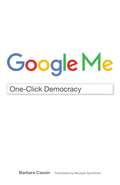
Google Me: One-Click Democracy (Meaning Systems)
By Barbara Cassin. 2018
“Google is a champion of cultural democracy, but without culture and without democracy.” In this witty and polemical critique the…
philosopher Barbara Cassin takes aim at Google and our culture of big data. Enlisting her formidable knowledge of the rhetorical tradition, Cassin demolishes the Google myth of a “good” tech company and its “democracy of clicks,” laying bare the philosophical poverty and political naiveté that underwrites its founding slogans: “Organize the world’s information,” and “Don’t be evil.” For Cassin, this conjunction of globalizing knowledge and moral imperative is frighteningly similar to the way American demagogues justify their own universalizing mission before the world.While sensitive to the possibilities of technology and to Google’s playful appeal, Cassin shows what is lost when a narrow worship of information becomes dogma, such that research comes to mean data mining and other languages become provincial “flavors” folded into an impoverished Globish, or global English.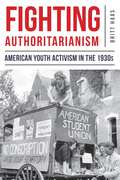
Fighting Authoritarianism: American Youth Activism in the 1930s
By Britt Haas. 2018
During the Great Depression, young radicals centered in New York City developed a vision of and for America, molded by…
their understanding of recent historical events, in particular the Great War and the global economic collapse, as well as by the events unfolding both at home and abroad. They worked to make their vision of a free, equal, democratic society based on peaceful coexistence a reality. Their attempts were ultimately unsuccessful but their voices were heard on a number of important issues, including free speech, racial justice, and peace. A major contribution to the historiography of the era of the Great Depression, Fighting Authoritarianism provides a new and important examination of U.S. youth activism of the 1930s, including the limits of the New Deal and how youth activists continually pushed FDR, Eleanor Roosevelt, and other New Dealers to do more to address economic distress, more inclusionary politics, and social inequality. In this study, author Britt Haas questions the interventionist versus isolationist paradigm in that young people sought to focus on both domestic and international affairs. Haas also explores the era not as a precursor to WWII, but as a moment of hope when the prospect of institutionalizing progress in freedom, equality, and democracy seemed possible.Fighting Authoritarianism corrects misconceptions about these young activists’ vision for their country, heavily influenced by the American Dream they had been brought up to revere: they wanted a truly free, truly democratic, and truly equal society. That meant embracing radical ideologies, especially socialism and communism, which were widely discussed, debated, and promoted on New York City college campuses. They believed that in embracing these ideologies, they were not turning their backs on American values. Instead, they believed that such ideologies were the only way to make America live up to its promises. This study also outlines the careers of Molly Yard, Joseph Lash, and James Wechsler, how they retracted (and for Yard and Lash, reclaimed) their radical past, and how New York continued to hold a prominent platform in their careers. Lash and Wechsler both worked for the New York Post, the latter as editor until 1980. Examining the Depression decade from the perspective of young activists highlights the promise of America as young people understood it: a historic moment when anything seemed possible.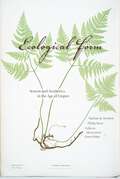
Ecological Form: System and Aesthetics in the Age of Empire
By Nathan K. Hensley, Philip Steer. 2019
Ecological Form brings together leading voices in nineteenth-century ecocriticism to suture the lingering divide between postcolonial and ecocritical approaches. Together,…
these essays show how Victorian thinkers used aesthetic form to engage problems of system, interconnection, and dispossession that remain our own. The authors reconsider Victorian literary structures in light of environmental catastrophe; coordinate “natural” questions with sociopolitical ones; and underscore the category of form as a means for generating environmental—and therefore political—knowledge. Moving from the elegy and the industrial novel to the utopian romance, the scientific treatise, and beyond, Ecological Form demonstrates how nineteenth-century thinkers conceptualized the circuits of extraction and violence linking Britain to its global network. Yet the book’s most pressing argument is that this past thought can be a resource for reimagining the present.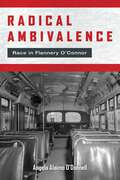
Radical Ambivalence: Race in Flannery O'Connor (Studies in the Catholic Imagination: The Flannery O'Connor Trust Series)
By Angela Alaimo O'Donnell. 2020
Radical Ambivalence is the first book-length study of Flannery O’Connor’s attitude toward race in her fiction and correspondence. It is…
also the first study to include controversial material from unpublished letters that reveals the complex and troubling nature of O’Connor’s thoughts on the subject. O’Connor lived and did most of her writing in her native Georgia during the tumultuous years of the civil rights movement. In one of her letters, O’Connor frankly expresses her double-mindedness regarding the social and political upheaval taking place in the United States with regard to race: “I hope that to be of two minds about some things is not to be neutral.” Radical Ambivalence explores this double-mindedness and how it manifests itself in O’Connor’s fiction.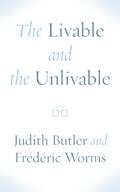
The Livable and the Unlivable
By Judith Butler, Frédéric Worms. 2023
The unlivable is the most extreme point of human suffering and injustice. But what is it exactly? How do we…
define the unlivable? And what can we do to prevent and repair it? These are the intriguing questions Judith Butler and Frédéric Worms discuss in a captivating dialogue situated at the crossroads of contemporary life and politics. Here, Judith Butler criticizes the norms that make life precarious and unlivable, while Frédéric Worms appeals to a “critical vitalism” as a way of allowing the hardship of the unlivable to reveal what is vital for us.For both Butler and Worms, the difference between the livable and the unlivable forms the critical foundation for a contemporary practice of care. Care and support, in all their aspects, make human life livable, that is, “more than living.” To understand it, we must draw on the concrete practices of humans who are confronted with the unlivable: the refugees of today and the witnesses and survivors of past violations and genocide. They teach us what is intolerable but also undeniable about the unlivable, and what we can do to resist it. Crafted with critical rigor, mutual respect, and lively humor, the compelling dialogue transcribed and translated in this book took place at the École Normale Supérieure (ENS) on April 11, 2018, at a time when close to two thousand migrants were living in nearby makeshift camps in northern Paris. The Livable and the Unlivable showcases this 2018 dialogue in the context of Butler’s and Worms’s ongoing work and the evolution of their thought, as presented by Laure Barillas and Arto Charpentier in their equally engaging introduction. It concludes with a new afterword that addresses the crises unfolding in our world and the ways a philosophically rigorous account of life must confront them.While this book will be of keen interest to readers of philosophy and cultural criticism, and those interested in vitalism, new materialism, and critical theory, it is a far from merely academic text. In the conversation between Butler and Worms, we encounter questions we all grapple with in confronting the distress and precarity of our times, marked as it is by types of survival that are unlivable, from concentration camps to prisons to environmental toxicity, to forcible displacement, to the Covid pandemic.The Livable and the Unlivable at once considers longstanding philosophical questions around why and how we live, while working to retrieve a philosophy of life for today’s Left.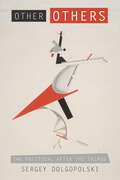
Other Others: The Political after the Talmud
By Sergey Dolgopolski. 2018
Denying recognition or even existence to certain others, while still tolerating diversity, stabilizes a political order; or does it? Revisiting…
this classical question of political theory, the book turns to the Talmud. That late ancient body of text and thought displays a new concept of the political, and thus a new take on the question of excluded others. Philosophy- and theology-driven approaches to the concept of the political have tacitly elided a concept of the political which the Talmud displays; yet, that elision becomes noticeable only by a methodical rereading of the pages of the Talmud through and despite the lens of contemporary competing theological and philosophical theories of the political. The book commits such rereading of the Talmud, which at the same time is a reconsideration of contemporary political theory. In that way, The Political intervenes both to the study of the Talmud and Jewish Thought in its aftermath, and to political theory in general.The question of the political for the excluded others, or for those who programmatically do not claim any “original” belonging to a particular territory comes at the forefront of analysis in the book. Other Others approaches this question by moving from a modern political figure of “Jew” as such an “other other” to the late ancient texts of the Talmud. The pages of the Talmud emerge in the book as a (dis)appearing display of the interpersonal rather than intersubjective political. The argument in the book arrives, at the end, to a demand to think earth anew, now beyond the notions of territory, land, nationalism or internationalism, or even beyond the notion of universe, that have defined the thinking of earth so far.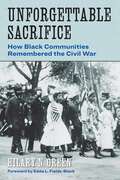
Unforgettable Sacrifice: How Black Communities Remembered the Civil War (Reconstructing America)
By Hilary N. Green. 2025
Rediscover the Civil War through the voices that refused to be silencedUnforgettable Sacrifice offers a groundbreaking exploration into the heart…
of African American memory of the Civil War, challenging conventional narratives and revealing a rich history preserved through oral traditions and communal efforts. Through extensive archival research and stories shared on the porches of African American families, Hilary Green provides a detailed examination of how diverse Black communities across the United States have actively preserved and contested the memory of the Civil War, from the nineteenth century to the present.By rejecting the reduction of their experiences to mere footnotes in history, African Americans have established a vibrant commemorative culture that respects the complexity of their ancestors’ sacrifices and struggles. From the rural landscapes of Black Pennsylvanians to the heart of emancipated communities in the South, Green connects the narratives of those who not only fought on battlefields but also in the realms of memory and heritage, ensuring their stories of resilience, courage, and patriotism are remembered.Unforgettable Sacrifice brings to light the untold stories of ordinary African Americans who took extraordinary steps in remembrance and resistance. By refusing to accept diluted narratives and lies, they have ensured the legacy of the Civil War includes the end of slavery, the valor of Black soldiers and civilians, and the ongoing struggle for democracy and full citizenship.This book is a testament to the enduring power of memory and the steadfast spirit of the African American community. It is an indispensable addition to the libraries of scholars, general readers, and descendant communities alike, offering new perspectives on the lasting impact of the Civil War on American identity and the persistent pursuit of justice and equality.